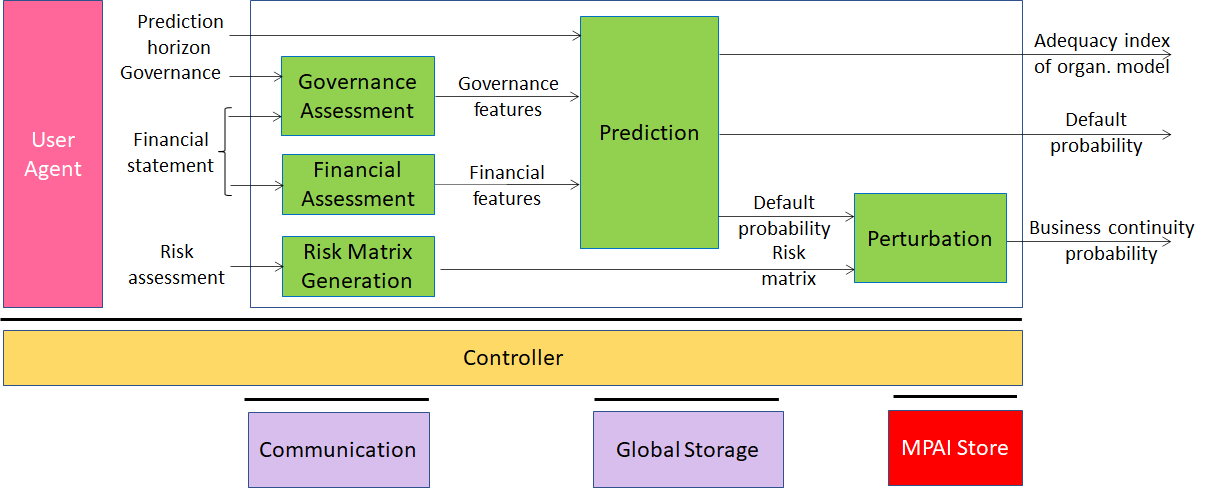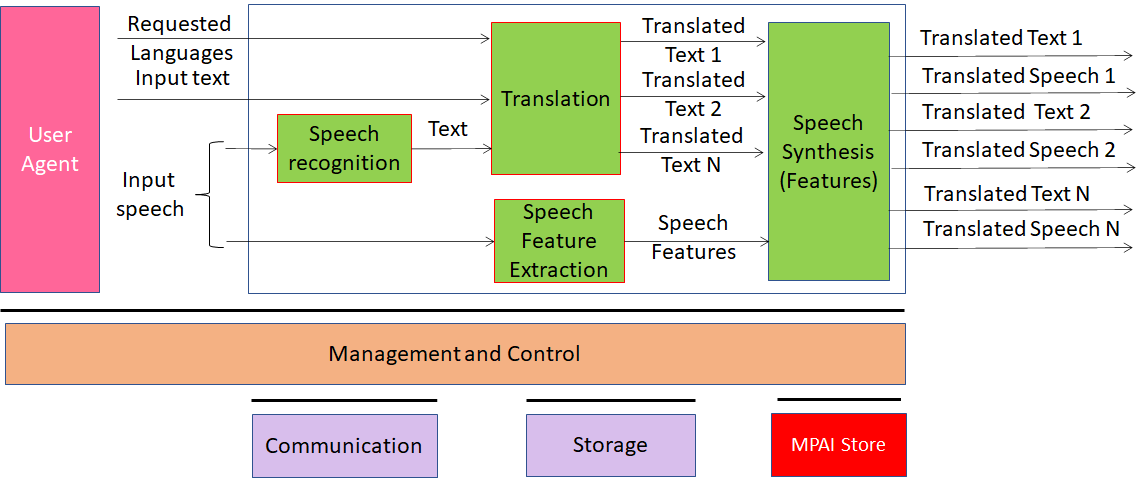One year after establishment MPAI publishes 3 standards
MPAI was established on 30 September 2020. On the same 30 September, one year later, MPAI is proud to announce that it has developed, approved and published 3 standards.
Compression and Understanding of Financial Data (MPAI-CUI)
The AI-based Company Performance Prediction of MPAI-CUI, predicts the performance of a company, from its governance, financial and risks data in a given time horizon of prediction.
The performance of a company is measured by:
- Default Probability (i.e., the default probability in a specified number of future months based on company financial features).
- Organisational Model Index (i.e., the adequacy of the organisational model).
- Business Discontinuity Index (i.e., the probability of an interruption of the operations of the company for a period of time less than 2% of the prediction horizon).
 Figure 2 – The MPAI Company Performance Prediction (CPP))
Figure 2 – The MPAI Company Performance Prediction (CPP))
Read the MPAI-CUI Standard for further details.
An online MPAI-CUI demo is available online.
The novelty of MPAI-CUI is in its ability to analyse, through AI, the large amount of data required by regulation and extract the most relevant information elements. Moreover, compared to state-of-the-art techniques that predict the performance of a company, MPAI-CUI allows extending the time horizon of prediction.
Companies, financial institutions can use MPAI-CUI in a variety of contexts:
- To support the company’s board in deploying efficient strategies. A company can analyse its financial performance, identifying possible clues to the crisis or risk of bankruptcy years in advance. It may help the board of directors and decision-makers to make the proper decisions to avoid these situations, conduct what-if analysis, and devise efficient strategies.
- To assess the financial health of companies applying for funds/financial help. A financial institution receiving a request for financial help from a troubled company, can access the company’s financial and organisational data and make an AI-based assessment, as well as a prediction of future performance of the company. This helps the financial institution to make the right decision whether funding that company or not, based on a broad vision of its situation.
Multimodal Conversation (MPAI-MMC)
The MPAI-MMC Application Standard presently specifies five use cases.
- In the Conversation with Emotion (CWE) use case, a human holds an audio-visual conversation with a computational system personified by a synthetic voice and an animated face.
- In the Multimodal Question Answering (MQA) use case, a human user requests and receives from a computational system spoken information concerning a displayed object.
- In three conversational translation use cases, a computational system translates from one spoken language to one or more other spoken languages. The translation path may be one-to-one from Language A to B only (in the Unidirectional Speech Translation (UST) use case); from Language A to B and vice versa (in the Bidirectional Speech Translation (BST) use case); or from Language A to B, C, … (in the One-to-Many Speech Translation (MST) use case). Synthetic spoken output can preserve specified features of the source language speech.
In all such use cases, MPAI-MMC specifies the implementation architecture; the AI modules comprising the topology; and the formats of the AIMs’ input and output data. And, based on the AI Framework (MPAI-AIF) specification, it defines the workflow linking the AIMs, along with their metadata.
 Figure 2 – The MPAI One-to-Many Speech Translation (MST)
Figure 2 – The MPAI One-to-Many Speech Translation (MST)
Read the MPAI-MMC Standard for further details.
The AIMs specified by MPAI-MMC modules are typically based on AI technologies but in some cases on data processing technologies – can be reused in more than one application scenario.
Multimodality is the essence of MPAI-MMC. Text, speech, and video are exploited, in both input and output data, to enhance user experience and improve human-machine interaction. This application standard will be valuable in AI industries aiming to enhance services based on human machine interaction of all sorts, particularly when the emphasis is on utilization of multimodal user interfaces enabling emotional expression through natural language and visual communication.
Governance of the MPAI Ecosystem (MPAI-GME)
MPAI does not consider its role accomplished with the publication of a Technical Specification. MPAI also delivers Reference Software, a conforming implementation of a Technical Specification whose components are written in a programming language. Some modules (AIM) are available in source code, and some other modules are provided in executable form. MPAI also provides the specification of the procedure, the tools and the data – Conformance Testing – to test the conformance of an implementation to a standard.
MPAI makes a further step. MPAI provides the specification of the procedure, the tools and the characteristics of the data – Performance Assessment – to assess the degree of Reliability, Robustness, Fairness and Replicability of an implementation, collectively called Performance.
The ecosystem created by MPAI standards includes the following: MPAI issuing standards, implementers developing implementations and end users using implementations. However, there are 3 serious questions whose answer determines the viability of the ecosystem.
- Who verifies the security of an implementation?
- Who tests the conformance of an implementation?
- Who assesses the performance of an implementations?
MPAI has selected the approach, depicted in Figure 2, to:
- Establish the MPAI Store, an MPAI-controlled not-for-profit entity in charge of answering the first two questions, and
- Appoint Performance Assessors in charge of answering the third question.
 Figure 2 – The MPAI Ecosystem entities and their interactions
Figure 2 – The MPAI Ecosystem entities and their interactions
Read the MPAI-MMC Standard for further details.
The MPAI Store offers secure access to implementations executing AIWs composed of AIMs in AIF implementations that:
- Are proprietary – Level 1.
- Conform to MPAI application standards (e.g., MPAI-CUI and MPAI-MMC) – Level 2.
- Whose Performance has been assessed by a Performance Assessor – Level 3.
The MPAI Store always informs end users of the level of guarantee offered by an implementation.
AI can offer great new benefits to humankind. MPAI standards offer the way to practically promote and disseminate use of AI. The Governance of the MPAI Ecosystem assures implementers that the Store holds interoperable implementations and end users that the implementations they enjoy have undergone different levels of scrutiny.
MPAI meetings in October
The meeting if MPAI Groups until 27 October (date of the 13 General Assembly) are given in the table below. 4-8 etc are the days of the weeks in October. Attendance at meetings of groups in bold is restricted to MPAI members.
| Group name | 4-8 | 11-15 | 18-22 | 25-29 | Time |
| Mixed-reality Collaborative Spaces | 4 | 11 | 18 | 25 | 14 |
| AI Framework | 4 | 11 | 18 | 25 | 15 |
| Context-based Audio enhancement | 5 | 12 | 19 | 26 | 14:30 |
| Multimodal Conversation | 5 | 12 | 19 | 26 | 15:30 |
| Connected Autonomous Vehicles | 6 | 13 | 29 | 27 | 13 |
| AI-Enhanced Video Coding | 13 | 27 | 14 | ||
| AI-based End-to-End Video Coding | 6 | 29 | 14 | ||
| Compression and Understanding of Industrial Data | 13 | 27 | 15 | ||
| Server-based Predictive Multiplayer Gaming | 7 | 14 | 21 | 14:30 | |
| Communication | 7 | 21 | 15 | ||
| Industry and Standards | 8 | 22 | 14 | ||
| General Assembly (MPAI-13) | 27 |

